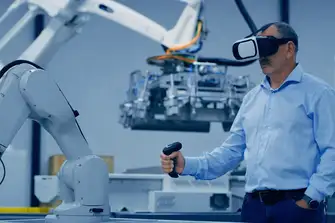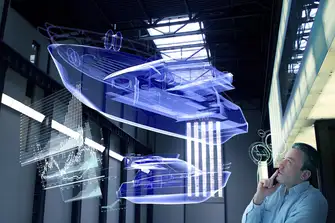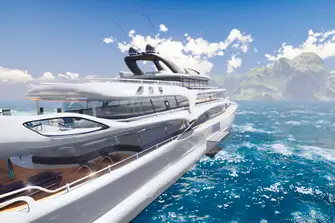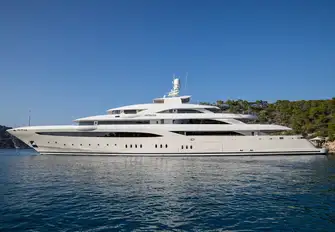 Burgess 50: Our top five social posts in 2025
Burgess 50: Our top five social posts in 2025

Exploring the metaverse: The future of yachting
Published 28 March 2024
Overhyped or inevitable?
The questions surrounding the metaverse are numerous. For many industries it is a question of when, not if, but when it comes to the world of superyachts, quite how this virtual world will affect the yachting industry’s future and in what scope is still unknown.
Technological advancements in the industry have increased ten-fold in recent years, with GPS navigation and high-speed internet connectivity found on board every yacht afloat, and developments in technologies that have changed the way that yachts are both built and operated. Artificial Intelligence (AI) technology is already in place on many yachts, with AI yacht management, navigation systems and operational sensors helping to streamline operations and maintenance.
How far technological advancements will go in yachting is yet unknown, but it is an ever-changing situation that has the potential to completely reshape the industry as we know it. Burgess takes a look at what the virtual world has in store for the industry and how it might affect everything from the consumer experience to the maintenance and operations, and even the design and build, of these magnificent vessels.
What is the metaverse?
The metaverse is essentially a virtual world online that exists in parallel with the real world. It offers its users a way to connect, collaborate and explore virtual realms through shared interactive and 3D experiences using virtual reality (VR), augmented reality (AR) and video.
Although the metaverse is still very much in its infancy, developers are out there building virtual experiences, and creating virtual worlds that will inevitably form part of our future. As such, businesses small and large cannot afford to ignore both its potential and pitfalls. Many of the more forward-thinking brands in the luxury sector are seeking ways in which the metaverse can be adopted to engage with new customers and revolutionise the way in which they interact with clients.
Luxury brands such as Gucci have already embraced the metaverse with virtual versions of products, while some yachting companies have adopted NFTs (Non-Fungible Tokens) and the use of cryptocurrency as part of their offering.
How can the metaverse benefit the yachting sector?
The metaverse allows users to engage and explore the yachting lifestyle, with virtual worlds and events hosted by high-profile brands targeting a new client base. The potential to reach new audiences and increase engagement, with prospective superyacht clients through metaverse marketing is an exciting prospect, as it allows for more interactive and unique content.
Given that a yacht can only be in one place at one time, virtual and augmented reality enables the potential end user to taste the experience before trying it for real. Virtual tours help buyers and charterers visualise a yacht that could be positioned anywhere in the world, allowing for a totally immersive and enhanced buying, or booking experience.

Complementing the metaverse, artificial intelligence (AI) is one area that many are predicting will revolutionise certain areas of the industry. From the safe and efficient running and maintenance of a yacht to navigation, there are all sorts of ways in which AI is poised to benefit a yacht’s operations. Already, AI systems can be used to monitor technical areas of the yacht, improving maintenance of the engine and other mechanical areas on board.
AI navigation systems can also plan the most efficient running of the yacht, and can be used to provide instant, real-time information on itineraries and route guidance, analysing weather patterns and sea conditions. It can predict near-future weather patterns through algorithms and analyse data to ensure the best experience for the yacht owner or charterer. Added to this are the benefits of improved data collection, allowing crewmembers and managers to improve a yacht's overall efficiency and forward planning.
How AI can benefit yacht ownership
From reduced costs, better preventative maintenance and improved safety, AI has the potential to streamline yacht management operations and therefore also potentially reduce running costs for any owner. Using AI for navigational and operational purposes makes for safer and more effective running of a yacht, but it requires a synergy between AI and human intelligence to be effective.
From navigational planning to fuel calculations, to running diagnostics and preventative maintenance, adopting AI for the operational running of a yacht, together with human interface, will ultimately help reduce the running costs for the owner. It will also benefit the environment as the yacht’s operations and efficiency are optimised, while the potential reduction of incidents due to human error gives an extra advantage.
How AI is being used by the superyacht industry
New and emerging technologies already have and will continue to change the way that yachts are designed, engineered and operated at such a fast pace that a few key industry players have already adopted AI and Augmented Reality (AR). From designers and shipyards to yacht managers, the industry is no longer simply experimenting.
Feadship, for example, is working on an AI and data optimisation system to run diagnostics and provide maintenance reports remotely to an owner; and Rossinavi has incorporated AI in concept yachts in the form of its BluE eco-centric navigation technology and AI engine which creates an ‘intelligent vessel’ to monitor habits and save energy, among other things. While technology is ready for some degree of autonomous navigation, however, costs and regulatory requirements mean that it is still not in full operation.

When it comes to the actual design of a superyacht then AI is a hot topic. Many of the leading designers have adopted some form of AI to aid in their superyacht design process, experimenting with generative AI to explore and inspire. However, rather than AI software, such as Midjourney and Dall-E, being used to design a yacht from start to finish, designers are using AI alongside other tools to produce visuals in a quicker way, thereby leaving the human yacht designer with more time to utilise their creativity.
Given that AI currently depends on existing data, there will always be a lack of innovation, along with issues of copyright and plagiarism. Added to this are the practical limitations of basic yacht design that only an experienced yacht designer understands. However, for technical calculations and optimising layouts and designs, AI can provide some excellent time saving measures and efficiencies.
Virtual superyachts in the form of Non-Fungible Tokens
One of the first examples that came out of the metaverse was the NFT (Non-Fungible Token). These are unique digital assets using blockchain technology that can be sold and traded within the metaverse in the same way that crypto currencies can be traded. A non-essential item, NFTs are about being part of an online community, with many NFTs having a substantial cost of entry and heightened social status in virtual social circles. Some NFT ownership also comes with real-life experiential bonuses including access to private parties, private membership clubs and exclusive VIP events. As with much of the metaverse, the yachting industry has embraced NFTs and a virtual mega yacht Metaflower sold for USD 650,000 in 2021.

How sustainable is the metaverse?
Whether using AI to create yacht simulations to make yachts more energy efficient or using the metaverse for virtual events, there are many ways in which the metaverse can be used to benefit the environment. However, data processing and storage comes at an environmental cost as the energy consumption of data centres is enormous, even with cloud data. Whether the benefits, including streamlined yacht operations and virtual travel allowing for reduced emissions, outweigh the pitfalls in terms of the vast energy consumption for data centres and VR technologies, along with concerns about intellectual property, we will need to ensure the metaverse is developed responsibly and sustainably.

Other technical advancements in yachting
Yachting has adopted some innovative ideas, with emerging technologies in sustainable propulsion being the primary one, but in comparison with other industries, such as the automotive and aviation industries, it is somewhat lagging, which is ironic given the largely entrepreneurial nature of the industry's client base. However, technology also means a lot more than propulsion.
We have already touched on virtual tours and the impacts of AI as systems start to analyse to provide predictive maintenance, and technological advances allowing for new ways to target clients, but there are also other examples of new technology that have already been embraced by the industry.
The way in which owners interact with their yacht has changed significantly, with maritime streaming services, such as the new Starlink Maritime, revolutionising the on board experience. Stabilisation systems have also become the norm on board most yachts and remain one of the most important technological advancements in terms of on-board comfort.
In the ever-evolving world of technology, it is hard to keep up with what to include in your yacht, or what to look out for when selecting a yacht for charter. At Burgess our experts can advise on which yacht is most suited to meet your requirements.
Stay up to date with the latest in yachting developments with Burgess. Enquire now.
To find out more about Burgess’ yachts for sale and yachts for charter, please contact a Burgess broker. Alternatively, get in touch with one of our offices directly: London, Monaco, New York, Miami, Singapore or all other locations.
Yachts, prices and availability are correct at the time of publication.

 Catamaran GOOD DAY SUNSHINE sold
Catamaran GOOD DAY SUNSHINE sold
 Last minute winter charter destinations
Last minute winter charter destinations

